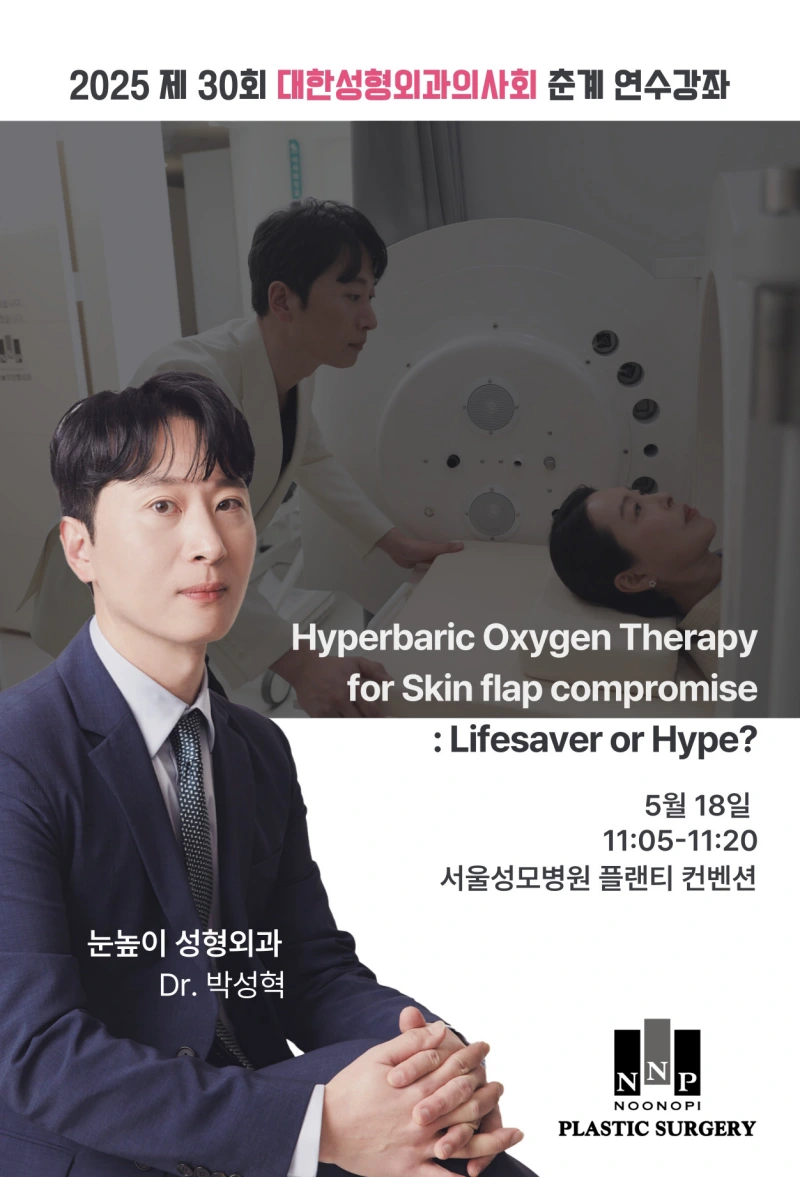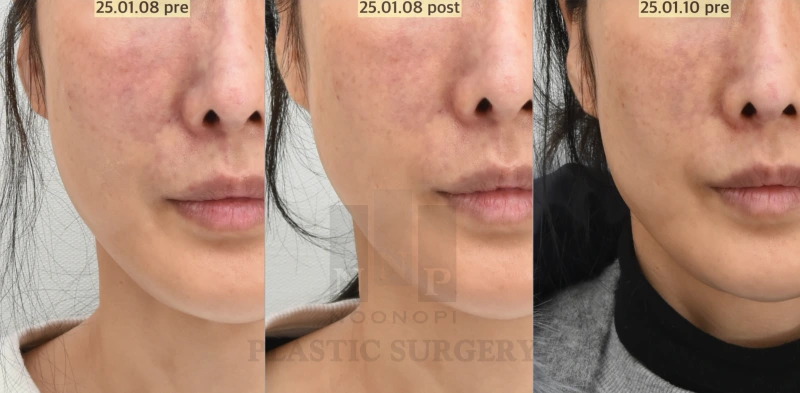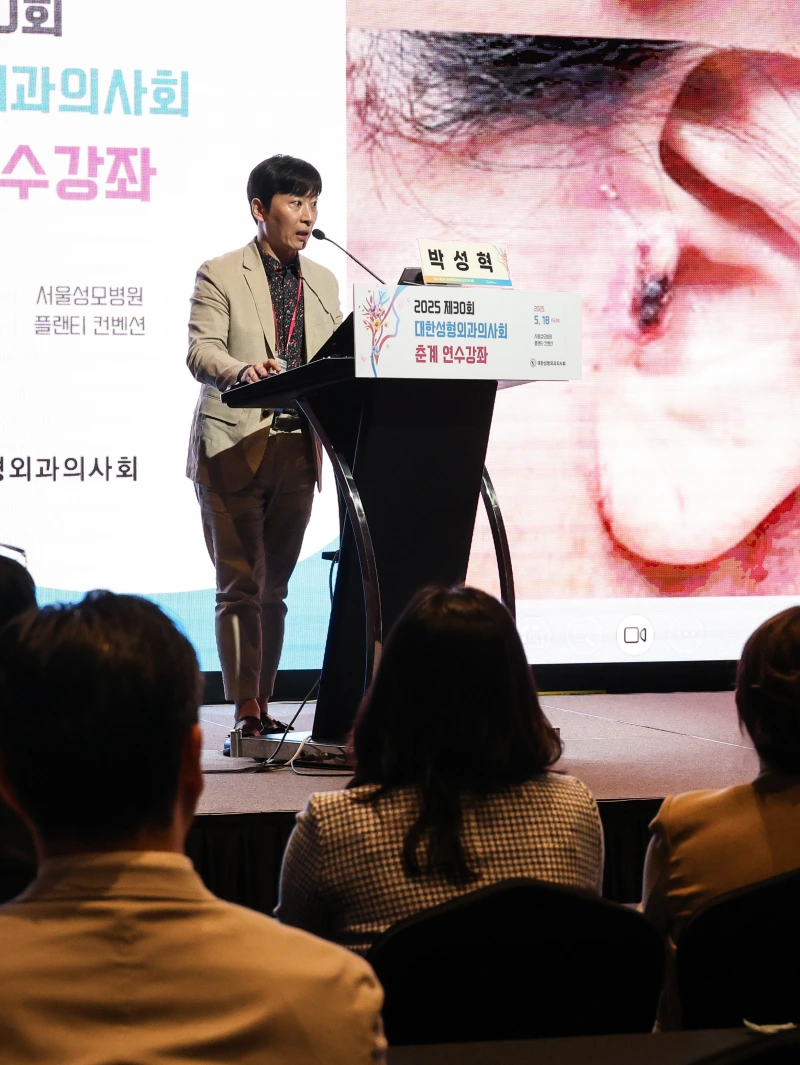In April, a heartbreaking story made headlines:
An influencer living in the U.S. reportedly lost her vision after a cosmetic skin procedure in Korea.
As I'm a board-certified plastic surgeon in Korea, I know what likely caused this tragedy.
Cases of blindness after filler injection have been documented since over a decade ago.


The leading cause is central retinal artery occlusion, typically due to filler accidentally entering the bloodstream and blocking critical vessels.
When reading the news, what came to my mind immediately was this very condition.
And I couldn’t help but wonder—could early hyperbaric oxygen therapy (HBOT) have helped preserve some of her vision?
Noonopi Korea Focus: Hyperbaric Oxygen Therapy for Safer Cosmetic Procedures
At Noonopi Plastic Surgery in Gangnam, we offer HBOT as part of our postoperative and complication management system. Earlier this year, I presented a lecture at the Korean Society of Plastic Surgeons titled:
“HBOT: Lifesaver or Hype for Skin Flap Compromise?”


Let’s now look at real-life examples from our clinic to show how HBOT helped reverse serious complications.
Why Do Fillers Sometimes Cause Complications?
Products like Juvelook Volume and other injectable Dermal fillers are widely used—but if the filler enters a blood vessel and blocks flow, it can lead to:
Skin necrosis (if the skin’s blood supply is cut off)
Blindness (if the arteries feeding the eye are blocked)
And this isn’t limited to fillers.
Any skin procedure that may disrupt vascular flow—facelifts, rhinoplasty, fat grafting—carries a small but serious risk of vascular compromise.
Early Signs of Vascular Compromise After Aesthetic Procedures
Bluish or dark skin discoloration
Delayed capillary refill time
Pain or sensory changes
Case 1: Filler-Induced Skin Necrosis Treated at Noonopi

A patient visited our clinic the day after receiving filler at another clinic. She noticed immediate skin color changes.
We quickly performed hyaluronidase injection to dissolve the filler and began HBOT the same day. Thanks to timely action, full-blown necrosis was avoided.
Does HBOT Really Help With Skin Necrosis?
Yes—timing is everything.
The earlier treatment begins, the better the chance of saving the skin and avoiding scars.
Case 2: Skin Necrosis After Facelift Surgery
This patient showed signs of compromised blood flow—dark, dusky skin— after facelift from our clinic.
With prompt HBOT and supportive care, the skin healed without the need for grafting.


Post-op: 6 week, 2 month, and 8 month
Case 3: Delayed Case – Rhinoplasty Skin Necrosis
What happens if the golden time is missed?

An international patient who had his third rhinoplasty from unkonwn surgeon had skin necrosis.

He arrived Noonopi Plastic Surgery at 3 weeks after the surgery. Despite the delay, we proceeded with HBOT—he even postponed his flight home to continue treatment.
Surprisingly, his skin began healing steadily—no grafts needed.

What Is HBOT?

Hyperbaric Oxygen Therapy (HBOT) is an advanced medical treatment that promotes healing by enhancing oxygen delivery to damaged tissues, particularly in plastic surgery for complications like skin necrosis.
HBOT involves breathing 100% oxygen in a pressurized chamber in high pressure (1.5–3.0 ATA).
It improves:
Tissue regeneration
Microvascular growth
Immune function
Skin survival in compromised areas
Hyperbaric Oxygen Therapy Pricing at Noonopi Plastic Surgery
We use the IBEX single-patient chamber for maximum comfort and effectiveness.
| 1.5 ATA Pressure | 2.5 ATA Pressure |
Purpose | Recovery support after plastic surgery, Anti-aging effect, Reduce swelling | Skin necrosis, Vascular issues, Severe complications, Chronic wounds |
45 min | $145 | $225 |
60 min | $175 | $245 |
90 min | $205 | $295 |
👉 Discounts available for treatment packages
⏱ Typical session length: 60–90 minutes
📅 Frequency: Based on condition severity and goals
What to Watch Out For
Before your HBOT session:
Equalizing pressure is very important—ear pain and dizziness are possible without instruction
Claustrophobia? Let us know during consultation
Patients with implants, pacemakers, or electronic devices should inform the clinic
Conditions Treated with HBOT
Skin necrosis after filler, facelift, or rhinoplasty
Carbon monoxide poisoning
Diabetic foot ulcers
Vascular compromise (e.g., Buerger’s disease)
Radiation-induced tissue damage
Intravenous drug-related skin necrosis
Final Thoughts: HBOT Is Not Hype—It’s Evidence-Based
Plastic surgery complications are rare—but when they occur, timing and treatment matter.
Hyperbaric oxygen therapy isn’t just a supportive option—it’s a science-backed method for increasing tissue survival and reducing long-term damage.
At Noonopi Plastic Surgery, we combine experience, precision, and advanced recovery tools like HBOT to ensure your safest, most successful outcome.

